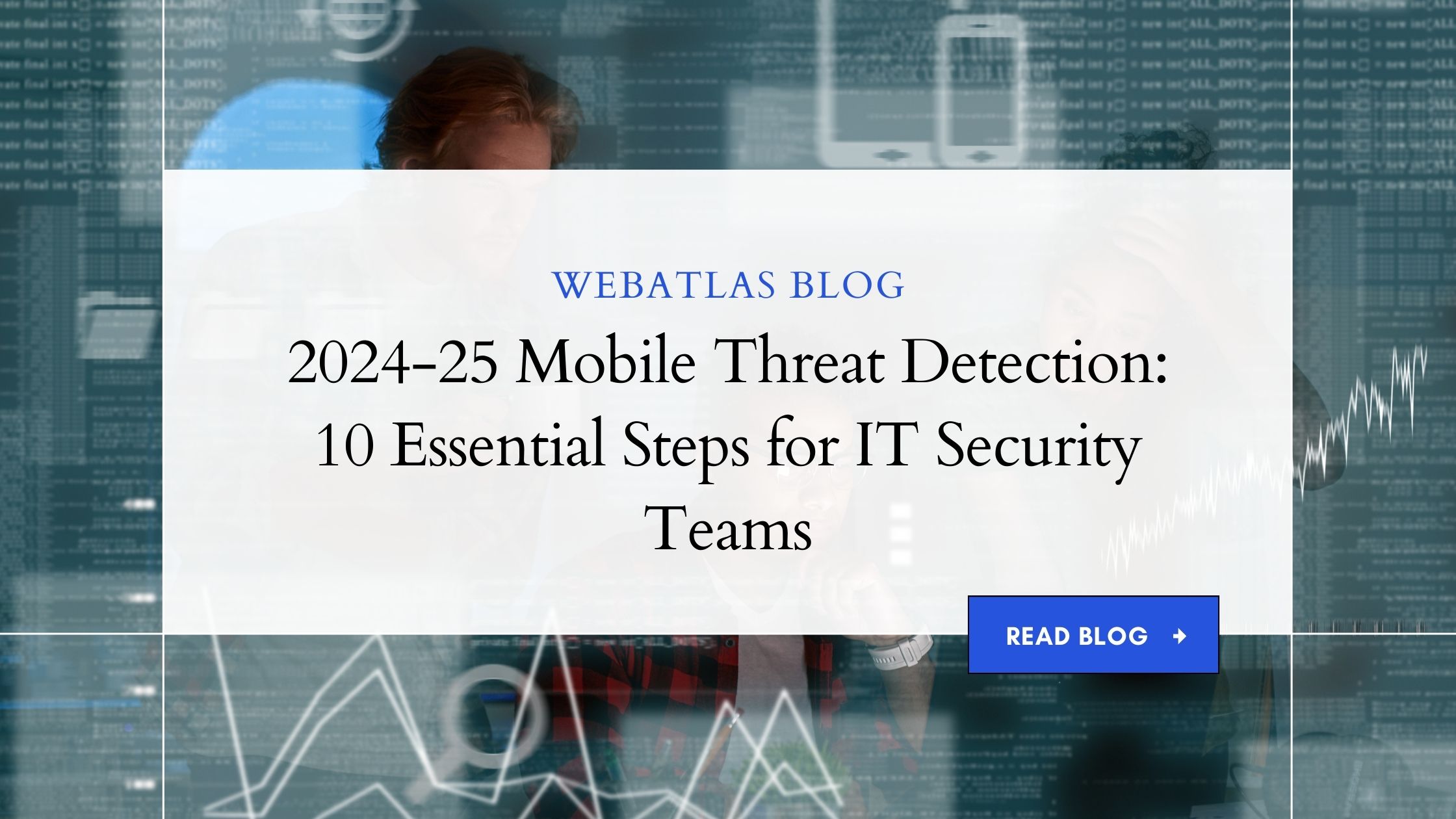10-Step Guide for IT Security Teams to Implement Effective Mobile Threat Detection in 2024-25

With the increasing reliance on mobile devices, IT security teams face the daunting task of protecting sensitive data from evolving threats. This guide outlines ten essential steps for implementing effective mobile threat detection strategies in 2024-2025.
Introduction
In today’s digital landscape, mobile devices have become integral to both personal and professional environments. As businesses continue to embrace mobility, the threat landscape has expanded, making mobile devices prime targets for cyberattacks. From malware and phishing attacks to data breaches and unauthorized access, the risks associated with mobile usage are growing in complexity. For IT security teams, implementing robust mobile threat detection is not just an option—it’s a necessity.
This guide provides a comprehensive, 10-step approach to implementing effective mobile threat detection, equipping IT security teams with the knowledge and tools they need to safeguard their organization’s mobile ecosystem in 2024-25.
Also Read- How to Develop Remote Patient Monitoring Software: A Comprehensive Guide
1. Conduct a Risk Assessment
The first step in implementing mobile threat detection is to conduct a thorough risk assessment. This involves identifying potential vulnerabilities in your organization’s mobile environment and understanding the types of threats that could exploit these vulnerabilities. Key areas to focus on include the types of mobile devices in use, the operating systems they run on, the applications installed, and the data accessed or stored on these devices.
By conducting a risk assessment, IT security teams can prioritize the most critical areas and allocate resources more effectively. This process should also involve evaluating the potential impact of a security breach, including financial losses, reputational damage, and legal consequences.
2. Establish a Mobile Security Policy
A comprehensive mobile security policy is the foundation of effective mobile threat detection. This policy should outline the acceptable use of mobile devices, security requirements, and guidelines for employees and contractors. It should also address issues such as BYOD (Bring Your Own Device), mobile device management (MDM), and the use of personal devices for work-related tasks.
Your mobile security policy should be regularly reviewed and updated to keep pace with evolving threats and technological advancements. Additionally, it’s crucial to ensure that all employees are aware of and adhere to the policy.
3. Implement Mobile Device Management (MDM) Solutions
Mobile Device Management (MDM) solutions play a critical role in managing and securing mobile devices within an organization. MDM solutions allow IT security teams to monitor, manage, and enforce security policies across all mobile devices in use. This includes features such as remote wipe, device encryption, application control, and compliance monitoring.
MDM solutions also enable IT teams to enforce security settings, such as requiring strong passwords, enabling device encryption, and disabling risky features like Bluetooth or camera access. By centralizing control over mobile devices, MDM solutions help reduce the risk of data breaches and ensure compliance with security policies.
4. Utilize Mobile Threat Defense (MTD) Tools
Mobile Threat Defense (MTD) tools are designed to detect and respond to threats targeting mobile devices. These tools use advanced technologies, such as machine learning and behavioral analysis, to identify suspicious activities and prevent potential attacks. MTD solutions can detect a wide range of threats, including malware, phishing attempts, network-based attacks, and vulnerabilities in applications or operating systems.
Implementing MTD tools provides an additional layer of security, helping IT teams to identify and respond to threats in real time. MTD tools can also integrate with existing security infrastructures, such as SIEM (Security Information and Event Management) systems, to provide a comprehensive view of the organization’s security posture.
5. Enforce Strong Authentication Mechanisms
Strong authentication mechanisms are essential for securing access to mobile devices and the sensitive data they contain. IT security teams should enforce multi-factor authentication (MFA) for accessing corporate resources, including email, VPNs, and enterprise applications. MFA combines something the user knows (e.g., a password) with something the user has (e.g., a security token or smartphone) or something the user is (e.g., biometric data), making it much harder for attackers to gain unauthorized access.
In addition to MFA, consider implementing biometric authentication methods, such as fingerprint scanning or facial recognition, which provide an added layer of security and convenience for users.
Must Read- How Much Does It Cost to Hire a React JS Developer in 2024?
6. Educate and Train Employees
One of the most effective ways to prevent mobile threats is to educate and train employees on security best practices. Many mobile security incidents result from human error, such as falling for phishing scams, downloading malicious apps, or connecting to unsecured Wi-Fi networks. By raising awareness and providing training, IT security teams can significantly reduce the likelihood of these incidents.
Training should cover topics such as recognizing phishing attempts, securing personal devices, avoiding risky apps, and using VPNs when accessing corporate resources from public networks. Regularly updating training materials to reflect the latest threats and incorporating real-world examples can help reinforce the importance of mobile security.
7. Secure Mobile Applications
Mobile applications are a common vector for cyberattacks, making it crucial to secure both the apps your organization develops and those it uses. For internally developed apps, ensure that security is integrated into the development lifecycle, from design to deployment. This includes conducting regular code reviews, vulnerability assessments, and penetration testing to identify and address security flaws.
For third-party apps, implement strict policies on app installation and usage. Consider using an enterprise app store where IT teams can vet and approve apps before they are made available to employees. Additionally, use app wrapping or containerization techniques to isolate corporate data from personal data on devices.
8. Monitor Network Traffic
Monitoring network traffic on mobile devices is essential for detecting and preventing malicious activity. IT security teams should implement solutions that provide visibility into the data being transmitted over both cellular and Wi-Fi networks. This includes identifying abnormal traffic patterns, detecting unauthorized data exfiltration, and blocking connections to known malicious servers.
Network monitoring tools can also alert IT teams to potential threats, such as man-in-the-middle attacks, rogue access points, or compromised devices attempting to connect to corporate networks. By continuously monitoring network traffic, organizations can quickly respond to emerging threats and prevent data breaches.
9. Regularly Update and Patch Devices
Keeping mobile devices and applications up to date is a fundamental aspect of mobile threat detection. Operating system updates and security patches address known vulnerabilities that could be exploited by attackers. IT security teams should enforce policies that require regular updates for all mobile devices used within the organization.
In addition to updating devices, ensure that all installed apps are regularly updated to their latest versions. This helps protect against vulnerabilities in third-party applications that could be leveraged in an attack.
10. Conduct Regular Security Audits and Penetration Testing
Regular security audits and penetration testing are crucial for assessing the effectiveness of your mobile threat detection strategies. These assessments help identify weaknesses in your mobile security posture, allowing IT teams to address them before they can be exploited by attackers.
Security audits should cover all aspects of mobile security, including device management, application security, network monitoring, and employee training. Penetration testing simulates real-world attacks to identify vulnerabilities and test the effectiveness of your defenses. By conducting these assessments regularly, organizations can stay ahead of emerging threats and continuously improve their mobile security strategies.
Expertise of Webatlas in Web Development and Mobile App Development
At Webatlas, we understand the critical role that mobile security plays in the success of any digital strategy. As a leading provider of web development and mobile app development services, we specialize in creating secure, robust, and scalable solutions that meet the unique needs of our clients.
Web Development Services
Webatlas offers a comprehensive suite of web development services designed to help businesses establish a strong online presence. Our team of experienced developers is skilled in building secure, user-friendly websites and web applications that are optimized for performance. We follow best practices in web security, including implementing HTTPS, conducting regular security assessments, and ensuring compliance with industry standards.
Mobile App Development Services
In the mobile app development space, Webatlas excels at creating innovative, secure, and user-centric mobile applications. We prioritize security at every stage of the development process, from designing secure app architectures to implementing robust encryption protocols. Whether you need a native app for iOS or Android, or a cross-platform solution, our team has the expertise to deliver high-quality, secure mobile apps that enhance your business operations.
Commitment to Security
At Webatlas, we are committed to helping our clients navigate the complexities of mobile security. We stay up-to-date with the latest threats and security trends, ensuring that our solutions are built to withstand the evolving threat landscape. Our expertise in web and mobile app development, combined with our focus on security, makes Webatlas the ideal partner for organizations looking to implement effective mobile threat detection and secure their digital assets.
Conclusion
Implementing effective mobile threat detection is a critical task for IT security teams in 2025. By following the 10 steps outlined in this guide—conducting risk assessments, establishing mobile security policies, utilizing MDM and MTD tools, enforcing strong authentication, and more—organizations can significantly reduce their vulnerability to mobile threats.
The growing reliance on mobile devices in the workplace means that security cannot be an afterthought. It must be integrated into every aspect of your mobile strategy. With the right tools, policies, and expertise, your organization can stay ahead of potential threats and ensure that your mobile ecosystem remains secure in 2024 and beyond.
Recent Post
Let's talk about your project, or just come and say hello!
Webatlas Technologies is the fastest growing web and mobile app development company



